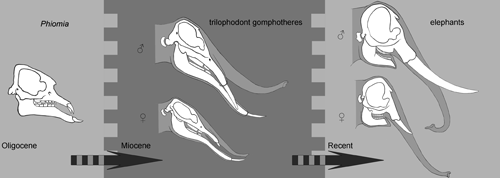Female preference promotes asynchronous sex evolution in proboscideans
What are the cause and innate power for the biological evolution? This is a controversial problem from ancient times to now. The interpretation for the evolutionary process is at an ambiguous phase although the academia admitting the existence of evolution has been at an absolute mainstream status. Neo-Darwinists seem to justify an explanation to this question with genetics and natural selection theory. This point also incurs much opposition. One of the important reasons is: the gene mutation is neutral, the trait selected from the gene mutation is an event with a very small probability; however, the real evolution is very rapid, the new species occurs in an abrupt way, for example, the mammals adaptively radiate rapidly after the extinction of dinosaurs at the end of the Mesozoic.
The researchers of the Institute of Vertebrate Paleontology and Paleoanthropology found that sexual selection has played a very important role in the process of biological evolution in addition to the natural selection. This may greatly improve our understanding of the evolutionary process. This new research is published in Vertebrata PalAsiatica, 2016, Volume 54, Issue 1.
The research on a population of Platybelodon grangeri from the Middle Miocene Zengjia site, Linxia Basin, Gansu, found that, on average, the males have more bulged neurocranium and more shrunk nasal bone than the females. Both traits are significant in the evolutionary process in proboscideans—both the bulged neurocranium and shrunk nasal bone are the advanced traits close to the modern elephants. This phenomenon not only occurs in Platybelodon, but also is found in Gomphotherium in the Middle Miocene, Europe. Therefore, in a sense, the male proboscideans seems to be more early evolved than the female ones in the Miocene; however, comparing to the skull features of modern African elephants, there is no such difference in both traits in females and males. This suggested the female proboscideans caught up with the male ones in evolution and leveled the differences in both in the Pliocene and Pleistocene. Meanwhile, it is notable that it is the Middle Micocene epoch that the quantity of proboscidean genus was the most and at a most prosperous evolutionary period; and the modern proboscidean is fading and its quantity of genus is sufficient to proof this point.
These phenomena show that the sexual differences closely related to the evolutionary process in proboscidean. In the first stage of proboscidean evolution, the male evolves faster than that of the female, the sexual differences between both of them is increased, and this stage is corresponding to the prosperity period of proboscidean; in the second stage, the male evolves slower than the female, the sexual difference between both of them is decreased, and this stage is corresponded to the decline period of proboscidean. The researchers interpreted the asynchronous sex evolution phenomena using Fisher (1930)’s female selection theory which presents that the male and female use different reproductive strategies. The male’s reproductive strategy is to seek more mating chances and improve the offspring birth rate as the male can yield a mega number of sperms; the female’s reproductive strategy is to seek a more quality male for mating and improve the offspring survival rate as the female can merely yield relatively-few eggs. Therefore, the female is more fastidious about the male and stronger in sexual selection. In the first evolution stage of proboscideans, it becomes more apparent for the female to more strongly select the male sexually. If the male has some progressed traits, then it is more acceptable to the female, and the offspring is remained in a large chances. This allows the progressed traits can be saved successfully during the revolutionary process. But at this stage, the female is more conservative in evolution, and the progressed traits are not manifested in the female (or in order to respond to the potential risks in the evolution). In the second stage, after the piloted progressed traits are reckoned as a successful revolutionary trait in males,and the female also gains such traits and reaches the same revolutionary level as the male. However, the female’s sexual selection on the male is resultantly decreased. Relating to the female, the male is not advantageous over the males in the traits, or the new developed traits in males are not reckoned as progressed ones and selected by females and the male attraction to the female is declined. The population loses a uniform evolutionary direction, reduces the reproductive ability to reproduce, and declines overall. Such phenomenon also exists in other mammalian species. For example, the modern Equidae, Rhinocerotidae and Giraffidae, etc. are fading, in which the sexual difference is typically very small and which are bred difficultly; and Cervidae, Bovidae, etc. are prosperous, in which the sexual difference is typically very big and which are bred easily.
The theory of heterochronic sexual evolution can interpret the cause, mechanism and innate power for the prosperity and decline of a large animal population. Because the sex selection is an active process, both males and females can greatly improve the trait selection efficiency by mating willingness so as to achieve the rapid evolution of species. This shows the great superiority of sexual reproduction over asexual reproduction, and the sex is generated for this reason.
This research is funded by the National Key Basic Research Development Program, CAS Strategic Priority Research Program, and the National Natural Science Foundation of China.

Fig.1 asynchronous sex evolution in proboscideans: sexual dimorphism increases initially, then decreases. (Provided by Wang ShiQi)
Download attachments: